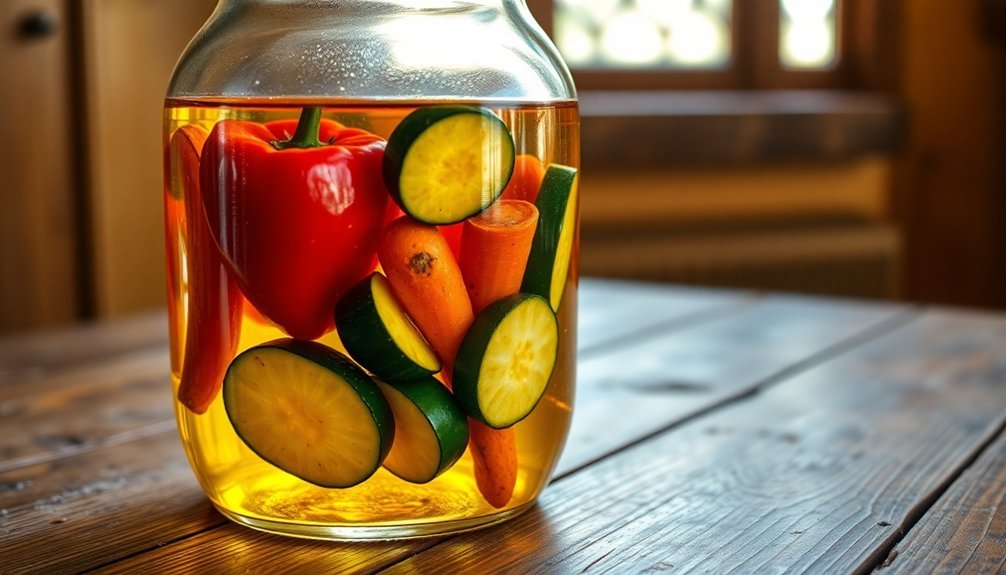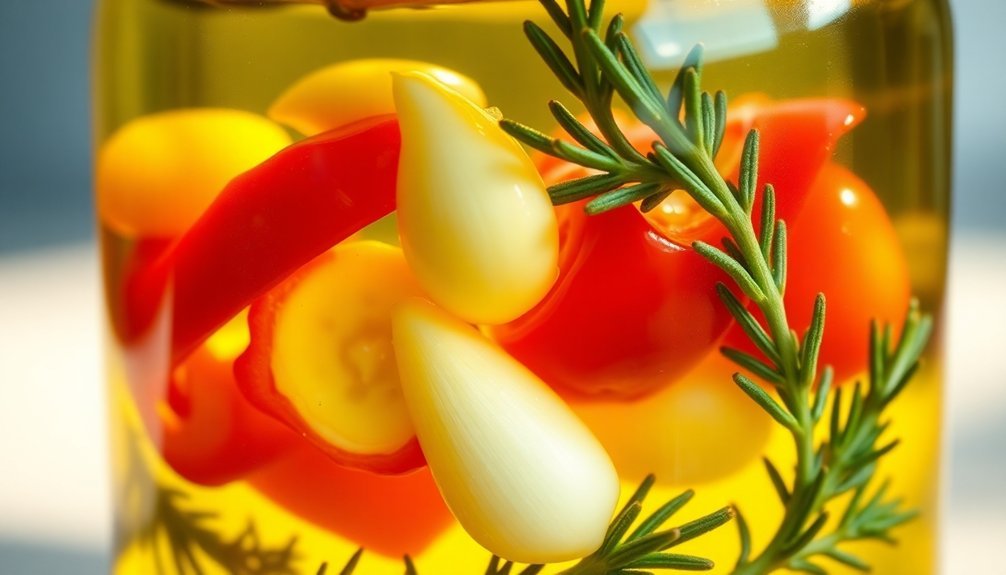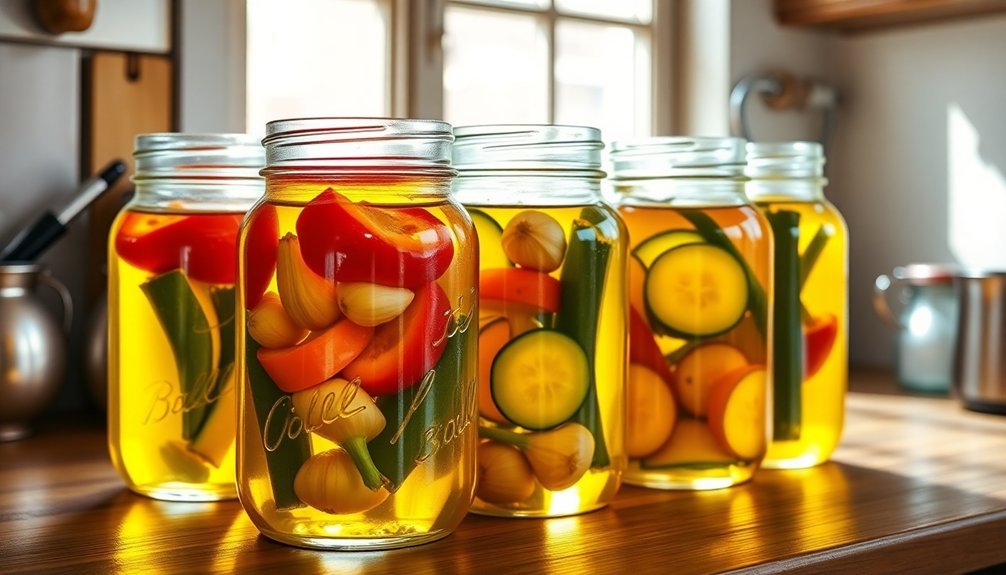Storing vegetables in olive oil offers multiple benefits for your kitchen and health. You'll extend shelf life while infusing your produce with complex flavors that develop over time. The oil acts as a natural preservative, protecting vegetables from spoilage while enhancing the absorption of fat-soluble nutrients like beta-carotene and lycopene. It's particularly effective for ingredients like bell peppers, zucchini, and sun-dried tomatoes, transforming them into versatile additions for salads, pasta, and antipasti platters. Though the technique requires specific safety measures and proper storage conditions, mastering this ancient preservation method can revolutionize your approach to seasonal cooking.
Historical Roots of Oil Preservation

The practice of preserving vegetables in oil dates back to ancient civilizations, where people discovered that submerging food in oil created an oxygen-free environment that prevented spoilage.
You'll find evidence of this preservation method in ancient Greek and Roman cultures, where they commonly used oil to preserve herbs and vegetables, though not as frequently as other preservation techniques.
While ancient societies relied primarily on drying, fermenting, and salting their foods, oil preservation offered a unique alternative. The addition of herbs and garlic to infuse flavor became a popular enhancement to this preservation method.
You'd often see this method combined with other preservation techniques, such as adding acidic ingredients like vinegar or lemon juice to soften the vegetables before storing them in oil. This combination approach helped guarantee better preservation results.
When you compare oil preservation to other historical methods, you'll notice it wasn't as widespread as pickling, sugaring, or fermenting.
These alternatives were often preferred because they relied on readily available ingredients like salt, honey, or natural fermentation processes.
However, oil preservation has evolved over time, and today you'll find modern adaptations that incorporate refrigeration and precise oil-to-acid ratios to guarantee food safety and extend shelf life.
Safety First: Essential Storage Guidelines
Several critical safety measures must be followed when storing vegetables in olive oil to prevent dangerous bacterial growth, particularly from Clostridium botulinum.
When you're working with low-acid foods like garlic, mushrooms, or chili peppers, you'll need to be especially vigilant since these ingredients can harbor harmful bacteria in oil's oxygen-free environment.
You must refrigerate any mixtures containing fresh vegetables or herbs in oil and use them within 4 days. If you're planning for longer storage, freeze the mixture immediately and thaw it only when you're ready to use it. Just like with tender salad greens, storing oil-based mixtures requires quick consumption to prevent spoilage.
Don't store refrigerated mixtures longer than 3 weeks, as bacterial growth can accelerate even at cold temperatures.
For safer storage options, you can remove solids from flavored oils by straining through cheesecloth, use the hot oil infusion method, or acidify with vinegar or lemon juice.
If you're working with dried ingredients only, you can safely store them at room temperature.
Remember to label all containers with preparation and use-by dates, and always guarantee your utensils and containers are clean to prevent contamination.
Nutritional Benefits Beyond Simple Storage

Beyond safe storage practices, storing vegetables in olive oil offers remarkable nutritional advantages that enhance your food's health benefits. When you combine vegetables with olive oil, you'll reveal improved bioavailability of essential nutrients like carotenoids and polyphenols, making them more accessible to your body.
You're not just preserving food; you're creating a powerful nutritional synergy. The olive oil helps transfer bioactive compounds from vegetables like tomatoes, onions, and garlic, while simultaneously protecting and enhancing their antioxidant properties. The oil's fatty acids facilitate better absorption of fat-soluble vitamins and other nutrients from your stored vegetables. Storing vegetables in olive oil at ideal room temperature between 55-60°F ensures optimal preservation of nutrients.
The phenols in olive oil, particularly abundant in extra-virgin varieties, work as potent antioxidants that combat harmful free radicals in your body. When you store vegetables this way, you'll maintain these beneficial compounds while creating a combination that supports cardiovascular health and insulin sensitivity.
This preservation method mirrors the principles of the Mediterranean diet, where the interaction between olive oil and vegetables produces enhanced health outcomes through improved nutrient absorption and increased anti-inflammatory effects.
Mediterranean Magic in Modern Kitchens
You'll find that storing vegetables in olive oil bridges the age-old Mediterranean preservation techniques with modern kitchen convenience.
By embracing this traditional method, you're not just storing food but creating versatile ingredients that can transform your everyday cooking into vibrant Mediterranean-inspired dishes.
Your preserved vegetables will naturally absorb the rich flavors of extra virgin olive oil while maintaining their nutrients, making them perfect for quick, flavorful additions to salads, sandwiches, and pasta dishes.
Ancient Preservation Meets Today
Ancient Mediterranean civilizations left us three remarkable gifts that still enhance our modern kitchens: olive oil, preservation techniques, and a deep understanding of flavor development. When you preserve vegetables in olive oil today, you're participating in a tradition that dates back to the Greeks and Romans, while gaining significant nutritional benefits. You'll find that roasting vegetables before preservation enhances their natural sweetness, just as ancient cultures discovered.
| Technique | Ancient Practice | Modern Benefit |
|---|---|---|
| Oil Ratio | 2:1 oil to vinegar | Prevents bacterial growth |
| Storage | Cool, dark amphoras | Sterile glass jars |
| Preparation | Sun-dried vegetables | Roasted vegetables |
| Duration | 6+ months | 6 months refrigerated |
You'll appreciate how this preservation method not only extends shelf life but also increases nutrient absorption. The oil helps your body absorb up to 80% more lycopene from tomatoes and retains 90% of vitamins B and C. When you combine ancient wisdom with modern food safety knowledge, you'll create perfectly preserved vegetables that maintain their nutritional value while developing complex, Mediterranean-inspired flavors.
Mediterranean Flavor Fusion
The fusion of Mediterranean and modern kitchen design creates a stunning blend of functionality and timeless charm.
You'll find natural materials like wood and stone paired with state-of-the-art appliances, creating a space that's both warm and efficient. This marriage of old and new perfectly complements the practice of preserving vegetables in olive oil, a technique that's as practical as it's flavorful.
To maximize your Mediterranean-inspired kitchen's potential, consider these essential elements:
- Install LED lighting under cabinets to illuminate your workspace while maintaining the warm ambiance created by earthy tones and textured surfaces.
- Incorporate wrought iron accents and terracotta flooring to achieve authentic Mediterranean charm while keeping modern conveniences accessible.
- Design open shelving using natural materials to display your preserved vegetables in oil, creating both functional storage and visual appeal.
Your preserved vegetables will find their perfect home in this fusion kitchen, where you can easily access them for antipasti platters or quick pasta dishes.
The combination of traditional preservation methods and contemporary kitchen design doesn't just look good—it enhances your cooking experience and helps maintain the nutritional value of your preserved foods.
Natural Nutrient Enhancement
Modern research reveals that storing vegetables in olive oil isn't just about preservation – it's a powerful way to enhance their nutritional value.
When you store vegetables in extra virgin olive oil, you're actually boosting their antioxidant content and improving the bioavailability of essential nutrients.
Your vegetables will retain more phenolic compounds and antioxidants, as the oil transfers its own beneficial compounds like oleuropein and hydroxytyrosol to the vegetables.
You'll also maximize the absorption of fat-soluble nutrients, including carotenoids like beta-carotene and lycopene, which your body can't properly utilize without healthy fats.
The oil acts as a protective shield, helping preserve water-soluble vitamins and minerals that might otherwise be lost through traditional cooking methods.
You'll maintain higher levels of vitamin C and B vitamins, while the antioxidants in olive oil prevent nutrient degradation during storage.
Best Vegetables for Oil Storage

For successful oil storage, certain vegetables require specific preparation methods to guarantee safety and longevity.
You'll find that vegetables like bell peppers, zucchini, and green beans must be cooked and acidified before being submerged in oil. This preparation process guarantees they're safe for consumption and prevents harmful bacterial growth.
Sun-dried tomatoes stand out as an excellent choice for oil preservation due to their natural acidity, which concentrates during the drying process. You don't need additional acidification, making them one of the most straightforward options for oil storage.
- Dried vegetables like capsicums, chilies, and ginger must be thoroughly dried until crisp before storage to eliminate moisture that could lead to spoilage.
- Raw garlic and herbs require refrigeration and shouldn't be stored for more than 3-4 weeks to prevent botulism risk.
- Vegetables like beets and mushrooms need proper cooking and acidification before they're suitable for oil preservation.
When storing these vegetables, you'll need to verify they're completely submerged in oil and follow proper preparation techniques.
Remember that refrigeration requirements vary depending on the vegetable type and preparation method used.
Flavor Enhancement Through Time
You'll discover that storing vegetables in olive oil isn't just about preservation – it's also about developing deeper, more complex flavors over time.
Your vegetables and herbs will gradually infuse their essence into the oil, creating a rich tapestry of tastes that becomes more pronounced as days pass.
When you combine multiple ingredients like garlic, rosemary, and sun-dried tomatoes, you're setting the stage for layers of flavor that will continue to mature and meld together during storage.
Aging Enhances Taste Complexity
The art of aging vegetables in olive oil yields remarkable flavor transformations over time. As your vegetables and herbs rest in the oil, they undergo a fascinating process where their flavor compounds gradually dissolve and meld together. This slow infusion creates a more complex and balanced taste profile that you won't achieve through quick preparation methods.
When you store your vegetables in olive oil, beneficial chemical changes occur that enhance both flavor and aroma. The oil acts as a medium for the vegetables' cellular structures to break down naturally, releasing their essential compounds into the surrounding liquid. You'll notice that the flavors become more integrated and harmonious as time passes.
Here's what happens during the aging process:
- The oil absorbs the aromatic properties of the vegetables, creating a more nuanced flavor profile.
- Natural oxidation processes contribute to the development of new, complex flavor compounds.
- The slow release of flavor compounds results in a richer, more balanced taste experience.
To maintain these enhanced flavors, you'll want to store your oil-preserved vegetables properly in the refrigerator or freezer, which helps preserve their flavor integrity while ensuring food safety.
Herbs Infuse Over Time
Delicate herbs gradually release their essential oils and aromatic compounds when immersed in oil, creating increasingly complex flavors over time. You'll find that room temperature infusion takes 1-10 days, with flavor intensity building progressively. For quicker results, you can heat the oil to 140°F for 5 minutes, though higher temperatures aren't recommended.
When creating your infusions, stick to a 1:10 ratio of herbs to oil, though you can adjust this based on your taste preferences. Choose either olive or canola oil as your base – olive oil adds its own complementary flavors, while canola oil lets the herbs shine through.
| Infusion Type | Duration | Storage Requirements |
|---|---|---|
| Room Temp | 1-10 days | Refrigerate 2-4 days |
| Heated | 5 minutes | Refrigerate 2-4 days |
| Fresh Herbs | Variable | Refrigerate/Freeze |
| Dried Herbs | Variable | Refrigerate/Freeze |
| Garlic | 1-10 days | Refrigerate 2-4 days |
Remember to refrigerate your infused oils within two hours of preparation and use them within 2-4 days. For longer storage, you can freeze the oil. Always label your containers with preparation and use-by dates.
Proper Equipment and Tools

Proper storage and preservation of vegetables in olive oil depends heavily on having the right equipment at hand.
You'll need clean, sterile jars with tight-fitting lids to prevent contamination and maintain a proper seal. Glass containers, especially mason jars, are your best choice as they're ideal for preserving vegetables in oil and won't react with the ingredients.
For the preparation process, you'll want to gather essential tools that'll make your preserving task easier and more efficient:
- A 9×13-inch baking dish and foil for roasting vegetables, plus an oven or grill to cook them before preservation
- Strainers, cheesecloth, or clean muslin cloth for removing excess moisture from vegetables, and a salad spinner for leafy greens
- Skewers or spoons for removing air bubbles from jars, plus specialized tools like garlic presses or zesters for adding flavoring elements
Don't forget to label your containers with preparation dates.
If you're planning to dry vegetables before preserving them in oil, a food dehydrator can be helpful but isn't essential.
Remember to avoid using containers that have previously held non-food items, as they might contaminate your preserved vegetables.
Temperature and Storage Considerations
For successful preservation of vegetables in olive oil, maintaining precise temperature control is absolutely essential. You'll need to keep your preserved vegetables between 32 to 40 degrees Fahrenheit to slow bacterial growth and maintain quality. The refrigerator is your best friend here, as it'll help prevent dangerous bacteria and botulism from developing.
When the olive oil hardens, that's your visual indicator that the vegetables are being stored at the right temperature.
You'll want to store your preserved vegetables in a well-ventilated area of your refrigerator, away from ripening fruits that release ethylene gas. While specific humidity isn't essential, aim for 65-70% relative humidity for ideal storage conditions.
Keep your vegetables completely submerged in a 2:1 ratio of olive oil to vinegar mixture, as this acidic environment helps prevent bacterial growth.
When you're ready to use your preserved vegetables, let them come to room temperature so the oil can liquify. With proper temperature control and storage conditions, your olive oil-preserved vegetables can last up to 1-2 months in the refrigerator. For extended storage, consider freezing them.
Cultural Impact on Preservation Methods

Traditional food preservation methods carry deep cultural significance that goes far beyond mere sustenance. When you store vegetables in olive oil, you're participating in a time-honored tradition that connects you to generations of food preservation knowledge. This practice, like many others, reflects the environmental adaptations and cultural priorities that communities have developed over centuries.
You'll find that preservation methods vary considerably across cultures, each reflecting unique regional conditions and available resources. These techniques aren't just about keeping food edible; they're about maintaining cultural identity and passing down ancestral wisdom.
Key cultural aspects of food preservation include:
- Intergenerational knowledge transfer through hands-on learning and oral traditions
- Integration with seasonal celebrations and community gatherings
- Development of distinct regional flavors and preparation methods
Understanding these cultural impacts helps you appreciate why certain preservation techniques have endured. When you preserve vegetables in olive oil, you're not just storing food; you're participating in a culinary legacy that has sustained communities for generations.
This method, like many traditional preservation techniques, continues to evolve while maintaining its cultural significance in modern kitchens.
Recipes and Serving Suggestions
Creating delicious preserved vegetables in olive oil starts with selecting the right combination of ingredients and preparation methods. You'll want to choose vegetables like beets, tomatoes, zucchini, eggplant, and peppers, along with aromatic herbs such as rosemary, thyme, and sage to enhance their flavors.
You can prepare your vegetables through various cooking methods. Slow-roasting at 400°F works well for Mediterranean vegetables, while grilling or steaming offers excellent alternatives. For a quick approach, you can sauté them in a skillet with olive oil and lemon juice, or use the parchment paper method with olive oil and water.
To preserve your vegetables properly, you'll need to create a marinade using 2 parts olive oil to 1 part vinegar. Make sure your vegetables are completely submerged in this mixture before storing them in sterile jars.
They'll keep in the refrigerator for up to 2 months, but remember to remove raw ingredients like garlic if storing longer than a week.
Your preserved vegetables are versatile in the kitchen. Add them to salads, pasta dishes, or sandwiches. They're perfect for antipasti platters, bruschetta, and even grilled cheese sandwiches.
Don't forget to use the flavored oil for dressings and sauces.
Frequently Asked Questions
Can I Reuse the Olive Oil After Removing All the Vegetables?
Yes, you can reuse the oil after straining out all vegetable particles through a fine mesh. Make sure it hasn't darkened or changed texture, and you'll be able to reuse it up to 5 times.
Will Mixing Different Vegetables in the Same Jar Affect Their Individual Flavors?
Yes, you'll find that different vegetables can transfer their flavors to each other when mixed in the same jar. Strong-flavored vegetables like asparagus or beets will especially impact the taste of milder ones.
Does the Quality of Olive Oil Affect Preservation Time?
Yes, the olive oil's quality directly impacts preservation time. You'll get longer-lasting results with high-quality extra virgin olive oil since it contains more antioxidants and polyphenols that protect your vegetables from spoilage.
Can I Add Fresh Vegetables to an Existing Jar of Preserved Ones?
You shouldn't add fresh vegetables to existing preserved ones. It'll increase bacterial growth risk and reduce shelf life to just a week. Instead, store fresh vegetables separately or create a new jar for them.
Should Vegetables Be Completely Dry Before Storing in Olive Oil?
Yes, you'll need to guarantee your vegetables are completely dry or properly acidified before storing in oil. If they're not dried thoroughly, moisture can create an environment where harmful bacteria could grow.
In Summary
Storing vegetables in olive oil isn't just about preservation – it's about transforming your ingredients into flavor-packed delicacies. You'll find that this age-old Mediterranean technique enhances both taste and texture while extending shelf life. Whether you're preserving summer's bounty or creating ready-to-use ingredients, you're participating in a culinary tradition that's both practical and delicious. Give it a try, and you'll wonder why you haven't been doing it all along.





Leave a Reply